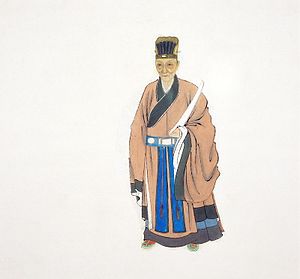Dong Qichang
Dong Qichang ( Chinese 董其昌 , Pinyin Dǒng Qíchāng , W.-G. Tung Ch'i-ch'ang ; * 1555; † 1636) was a painter, scholar and calligrapher of the outgoing Ming dynasty .
Life
Dǒng Qíchāng was born in 1555 in Huating, Jiangxi Province, the son of a teacher. At the age of twelve he passed the prefectural exam . In a later exam at the age of 17 he “only” came second because of his awkward calligraphy . This spurred Dǒng to improve his skills in this regard until he finally became a famous calligrapher. Then he gradually climbed the levels of the hierarchy of officials until he reached the highest level at 35. As a result, he worked for 45 years as tutor of the imperial princes and held important government posts.
Nonetheless, Dǒng was not without controversy: in 1605, for example, there was a protest demonstration by exam candidates against his appointment as examiner. Another time he is said to have insulted and beaten women who came to him with complaints, whereupon an angry mob set his house on fire. Dǒng also maintained close relationships with the palace eunuchs .
Working as a painter
Dǒng's work is stylistically based on the tradition of Yuan painting , especially Ni Zan . Like him, Dǒng refrains from populating his landscapes with people; rather, he lets nature work in its monumentality alone. In addition, Dǒng avoided anything subtle or sentimental and gave the expression priority over the lifelike reproduction of the object; For example, he worked with deliberately falsified spatial relationships and other deliberate dissonances, which Western art historians sometimes accuse him of as a mere expression of technical and manual inability. Dǒng's art had a great influence on the so-called individualists of the Qing period .
Art theory
In addition, Dǒng published a large number of art theoretical writings as well as hundreds of colophons on selected pictures. At that time, his dogmatic judgments and image attributions were highly binding, while the latter in particular are viewed more critically today.
In addition, Dǒng subjected all previous Chinese painting to a comprehensive systematization. In particular, the division of the Ming painters into a northern ( Zhe ) and a southern ( Wu ) school, which is still valid today, goes back to him ; The names are, of course, misleading insofar as they are not linked to the geographical origin of the artists, but to their proximity to the Zen Buddhist directions of the same name . The Zhe School consisted mainly of the academic professional painters , whom Dǒng had little respect for. The especially in the area of Suzhou and Songjiang -based Wu -School, who also imputing to Dǒng itself, however, united mainly to higher estimated dilettante literati painter.
plant
Dong Qichang's works are in the Guangzhou Museum of Art .
literature
- James Cahill : The Chinese Painting (= The Art Treasures of Asia. Vol. 1, ZDB -ID 503322-6 ). Skira, Geneva 1960.
Web links
- Works by Dong Qichang at Zeno.org .
| personal data | |
|---|---|
| SURNAME | Dong Qichang |
| BRIEF DESCRIPTION | Chinese painter |
| DATE OF BIRTH | 1555 |
| PLACE OF BIRTH | Huating |
| DATE OF DEATH | 1636 |

